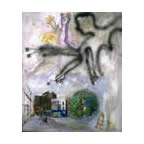 |
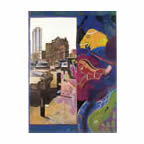 |
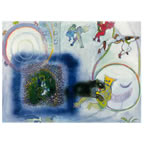 |
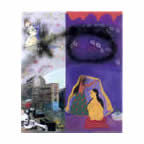 |
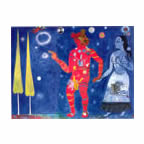 |
PAINTINGS of HEAVEN and HELL
Paul Gopal-Chowdhury in conversation with Michael Richardson
Looking around your studio at these new paintings the first question that
comes to mind is why you have given them the collective title "Paintings
of Heaven and Hell"?
The notion of Heaven and Hell is here with us. Living in London is stressful for me, but I realise that stress is also stimulating and if I lived in an idyllic place I couldn't do the paintings I do. I'm always hoping to escape. In a way the paintings are about a dialogue between reality and an alternative dream-like space.
You've spent many years living and working in the Spitalfields area of London. Has this been significant in making the work?
Yes. I'm attached to the streets where I live and I want to make a portrait of that part of London. The stains on the ground or the pavement are as important as the buildings, and the light is like no other part of London. At night it has this slightly reddish sky that reminds me of Calcutta, and for a while I genuinely believed there were demons there. It's a strange area. I think there are vibes in Spitalfields which are different from anywhere else, and I have felt I was being, in a sense got at or given something by being there.
The most striking thing about your new paintings is the Indian imagery and I'm curious to know why the Indian side of your background has been introduced into paintings that were previously very European in character?
Well firstly, I think the question is misleading because my earlier paintings have always had some non-European aspects whether in colour or line or just the disposition of things. Also, my earlier work wasn't just one thing, it was changing just as it is now. Of course the Indian imagery is different but that came about unconsciously. What I mean is that various things had been going on in my mind and eventually things come to the surface and you are then able to name these things. For me a change is usually accompanied by a crisis. Mine started about fifteen years ago, mainly because I came to a standstill with certain things I was doing. When I was painting from life I kept finding that I was only interested in two or three aspects of the subject. Instead of painting the whole scene I was painting parts, a profile and maybe a pair of hands and I'd want the rest not to interfere with that. I was cutting away and cutting away so that I was left with a fragment and the problem was how to set off the fragment. From there my paintings moved towards people walking and then came the notion of allowing arbitrary things to come in as a way of presenting the form wrapped in confusion (as it appears in reality). Then came the 'Angels and Street-Women' paintings which were painted largely from imagination. This was the beginning of the paintings becoming weightless, images that float, images which are mental rather than perceived. But really I was interested in having both, the perceived and the mental image being played off against each other. That's really how the paintings I'm now doing came about.
What is it about the Indian mythological imagery that has helped with the formal problems you've mentioned?
I don't understand anything about Indian mythology, but I have been able to use some aspects of the imagery. Of course it is transformed into a very different kind of painting with very different implications. For instance, Indian paintings don't have 'gravitational pull', the forms are weightless. You travel up and down and across with ease. European paintings are different because they have the influence of gravity. So by mixing the two I can re-distribute the various pictorial weights in my paintings. I'm raising the ante for myself. You see in certain paintings there is a surface image and then another image, if that's the right word. This other 'image' is where the play between forms really takes place. This doesn't occur in all painting and in earlier painting the 'play' was less explicit and the surface image had to carry most of the meaning. For me Cezanne was the turning point. After him the duality was really spelt out, but very few painters have been able to deal with this.
What do you mean by this idea of the other painting that goes on beneath the surface?
I find it odd that it doesn't happen very much today, but in the past you'd have someone like Velazquez painting Las Meninas which, in a sense is very true to life, but it's also a very wild and open painting. A lot of painting today has the realism but not the openness and it's the openness that interests me. A painting can have two images, one on the surface and another beneath the surface that contains the interplay of the parts. This is interesting because it allows the viewer to become involved. When you have this interplay the viewer can as it were, enter into the parts, they're not simply seeing a whole image, what they are getting is lots of aspects of an image, which are always in the process of becoming. This is one of the areas where painting really does score over photography because all photographic images are surface images only. Also, no photograph has the implied movement I've described relating to the interplay of forms. Photographs are inert. Of course most painting is inert too, but for different reasons.
Can you explain what you mean by "openness" in a painting?
Well I don't mean something that's so loose or vague that any interpretation can be put on it. It's when the structure of a painting seems to expand and grow as you look. For instance, you might enter through a colour and this opens up like a flower opening its petals to reveal another colour, a division of the first, or it's complementary. This in turn moves the eye along to perhaps a line, or a shape, but these will rhyme with or echo the colour. And it goes on like this, moving from colour to colour (these also contain forms and make new forms through their various combinations). So the painting is like a living organism.
Actually what one senses about the paintings is that the rainbow-like colours seem to wash over the city scenes.
For me the problem is augmentation. If I just paint high keyed saturated colours it's too lacking in density. If I paint local colours describing the buildings or the roads for example, the image becomes too static and clogged. So what I want is to open up and intensify the component parts and I do this by having one language leak into and affect another and vice versa.
So Indian mythological images have offered you a way of reinstating some of the complexity and bringing back into the work this idea of the dialogue of the parts?
Yes, I feel it gives me the chance to set the Indian imagery against urban scenes. I mean if you imagine a genre painting by an artist like de Hooch, wonderful light, painting of bricks, courtyard and so on, all beautifully painted but in a sense you don't really get enough intensity. You don't get the same intensity as you would if you took a chunk of it and put it into another world. It is by displacing one world and putting it against another that you see the form with a new intensity. That really interests me because this kind of play is the essence of painting. I want the painting to come over very fast and then delay the eye as it were, by enabling it to look at the movements between the various parts. Almost like an event or a happening, the painting goes on making and un-making itself as you look.
How do you start a painting, what prompts it?
You can't just will a painting into being. There was an entrepreneur I saw on television some time ago who had some elephants that were being used to move logs, and when the work was over he still had the elephants and he also had a stack of paints and canvases. So he decided to use the elephants by giving them brushes to hold in their trunks and they sloshed paint on the canvasses and were very productive. When the television interviewer asked the entrepreneur if he thought the paintings were any good he replied, "I don't say these are the best paintings in the world, but they are the best abstract paintings". If elephants could get a likeness they might paint equally good figurative paintings. And although paintings can't be willed there has to be a mind as well. So it's a paradox: if there's no mind you paint like an elephant but if you intervene too much the painting becomes forced and lifeless.
This rather suggests that you don't have a specific agenda for the way you want your work to develop. I realise of course that you don't just sit around waiting but presumably you can't force things either?
I have to wait for images to come and hope when they do I will recognise the ones that matter. I think that there is a lot of very competent painting made today but it's the painting that breaks new ground which counts. This is different from novelty. Something really new changes the way previous images are perceived. This is a very tall order and usually it takes a life-time before anyone really knows that a change has occurred. That's what interests me. I think it's possible to feel every day that you are just hanging on, not really there, not firmly in the seat, yet still doing something. That's how it is for me.
It makes the idea that painting is dead seem rather silly really.
It isn't
dead for me but there are many who think it has been superseded by photography.
We're living in a very busy world with many lines of visual communication
from the media and yet we're able to understand this bombardment of multiple
images when we couldn't thirty years ago. Painting has to keep up with
this, or it will become redundant.
I want more complexity and richness to be brought back, but I also want
all the parts of a painting to speak. This is an old idea really. I'm
attempting to restore some of the values that were lost when the mainstream
surrendered initially to the abstract expressionists and then to Duchamp.
These were reductive artists. I don't want to continue with that because
it was all done in the last century and there is no reason why an artist
now shouldn't try to do something complex again, like the Old Masters,
but obviously it has to work differently. You have to accept that the
great reductive artists of the last century, people like Picasso and Matisse
and others, made the ingredients important. They made every element count,
so if we are going to have a new complexity, everything has to count.
The complexity must heighten the emotion rather than diffuse it. It also
has to be controlled, because if it gets too complicated it's just a mess.
Recorded in the artist's studio November 2001.
An edited version appears in the exhibition catalogue